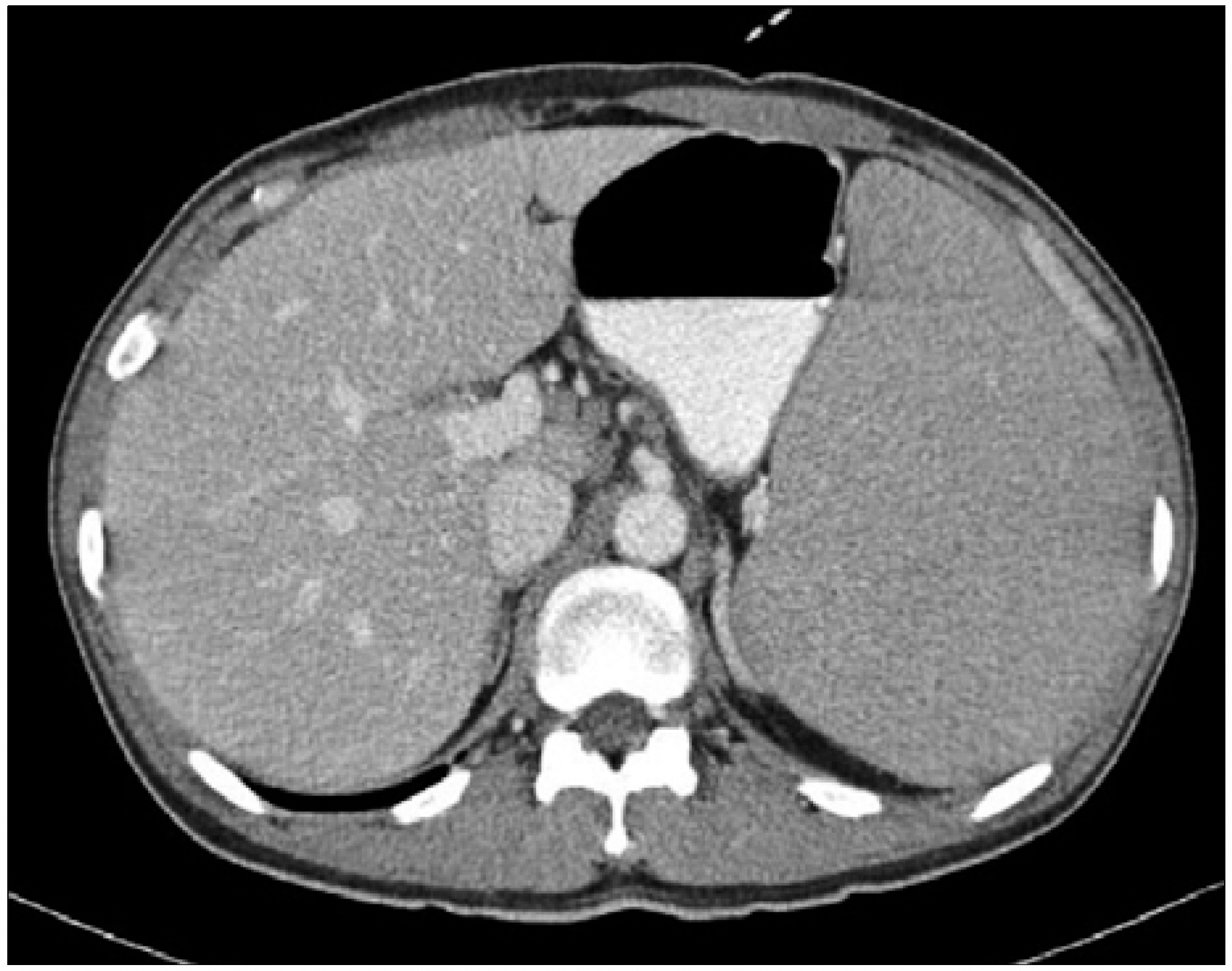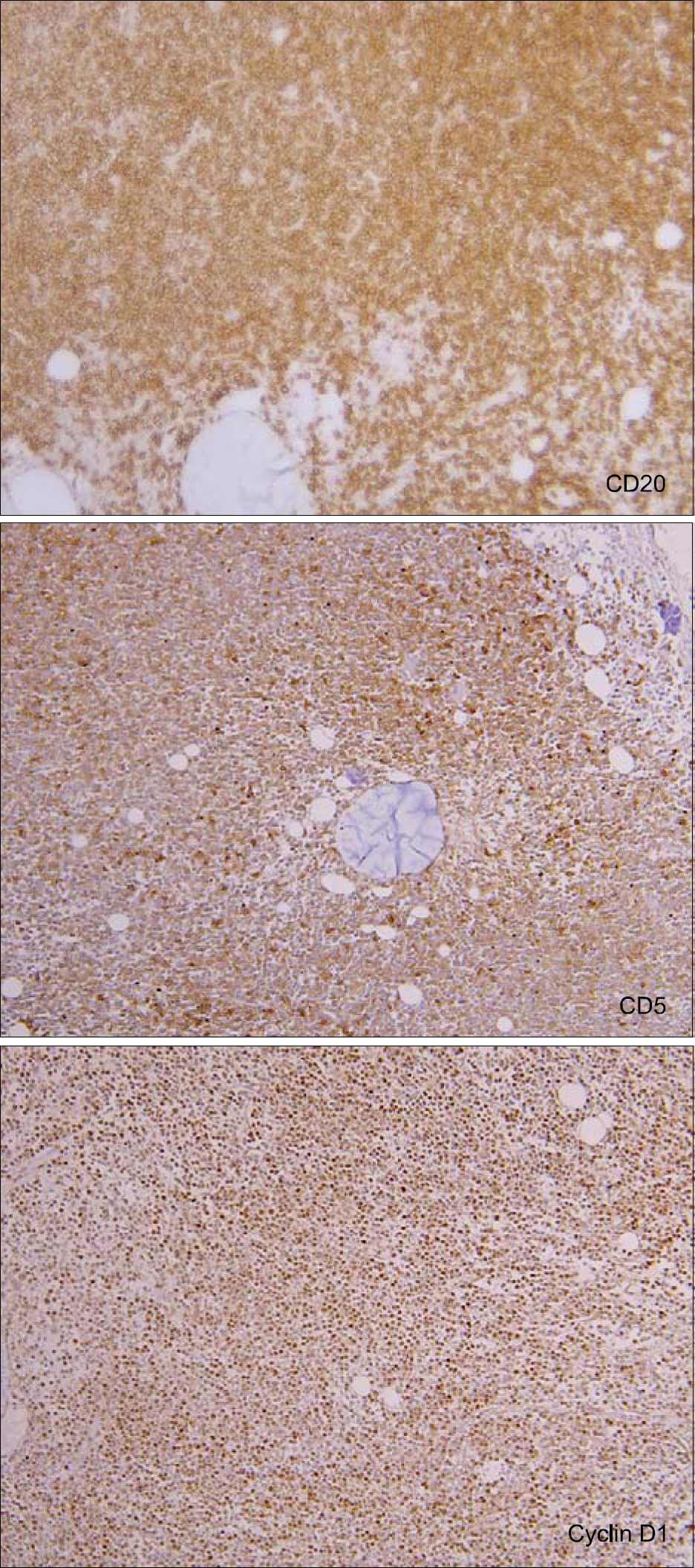Korean J Hematol.
2006 Sep;41(3):215-219. 10.5045/kjh.2006.41.3.215.
A Case of Mantle Cell Lymphoma Treated with Autologous Stem Cell Transplantation and Rituximab
- Affiliations
-
- 1Department of Internal Medicine, Pochon CHA University College of Medicine, Seongnam, Korea. sychong@cha.ac.kr
- 2Department of Radiation Oncology, Pochon CHA University College of Medicine, Seongnam, Korea.
- KMID: 2252305
- DOI: http://doi.org/10.5045/kjh.2006.41.3.215
Abstract
- Mantle cell lymphoma is a subtype of aggressive non-Hodgkin's lymphoma and usually presents in advanced stages. When treated with a regimen such as CHOP, the median survival is about three years. More aggressive front-line therapy with the hyper-CVAD regimen or high-dose therapy with stem cell support has shown encouraging results in several trials. The addition of rituximab to the chemotherapy regimens, or high-dose therapy, increased the response and survival rates in patients with mantle cell lymphoma. We report a case of mantle cell lymphoma that was successfully treated with aggressive front-line treatment strategies. The patient achieved complete remission with initial hyper-CVAD regimen, and was consolidated with autologous stem cell transplantation and subsequent rituximab.
MeSH Terms
Figure
Reference
-
1). Lenz G., Dreyling M., Hiddemann W. Mantle cell lymphoma: established therapeutic options and future directions. Ann Hematol. 2004. 83:71–7.
Article2). Fisher RI., Miller TP., O'Connor OA. Diffuse aggressive lymphoma. Hematology Am Soc Hematol Educ Program. 2004. 221–36.
Article3). Romaguera JE., Khouri IF., Kantarjian HM, et al. Untreated aggressive mantle cell lymphoma: results with intensive chemotherapy without stem cell transplant in elderly patients. Leuk Lymphoma. 2000. 39:77–85.
Article4). Romaguera JE., Fayad L., Rodriguez MA, et al. High rate of durable remissions after treatment of newly diagnosed aggressive mantle-cell lymphoma with rituximab plus hyper-CVAD alternating with rituximab plus high-dose methotrexate and cytarabine. J Clin Oncol. 2005. 23:7013–23.
Article5). Khouri IF., Saliba RM., Okoroji GJ., Acholonu SA., Champlin RE. Long-term follow-up of autologous stem cell transplantation in patients with diffuse mantle cell lymphoma in first disease remission: the prognostic value of β2-microglobulin and the tumor score. Cancer. 2003. 98:2630–5.6). Teodorovic I., Pittaluga S., Kluin-Nelemans JC, et al. Efficacy of four different regimens in 64 mantle-cell lymphoma cases: clinicopathologic comparison with 498 other non-Hodgkin's lymphoma subtypes. European Organization for the Research and Treatment of Cancer Lymphoma Cooperative Group. J Clin Oncol. 1995. 13:2819–26.
Article7). Hiddemann W., Unterhalt M., Herrmann R, et al. Mantle-cell lymphomas have more widespread disease and a slower response to chemotherapy compared with follicle-center lymphomas: results of a prospective comparative analysis of the German Low-Grade Lymphoma Study Group. J Clin Oncol. 1998. 16:1922–30.
Article8). Foran JM., Rohatiner AZ., Cunningham D, et al. European Phase II Study of Rituximab (chimeric anti-CD20 monoclonal antibody) for patients with newly diagnosed mantle-cell lymphoma and previously treated mantle-cell lymphoma, immunocytoma, and small B-cell lymphocytic lymphoma. J Clin Oncol. 2000. 18:317–24.
Article9). Ghielmini M., Schmitz SF., Cogliatti S, et al. Effect of single-agent rituximab given at the standard schedule or as prolonged treatment in patients with mantle cell lymphoma: a study of the Swiss Group for Clinical Cancer Research (SAKK). J Clin Oncol. 2005. 23:705–11.
Article10). Forstpointner R., Dreyling M., Repp R, et al. The addition of rituximab to a combination of fludarabine, cyclophosphamide, mitoxantrone (FCM) significantly increases the response rate and prolongs survival as compared to FCM alone in patients with relapsed and refractory follicular and mantle cell lymphomas: results of a prospective randomized study of the German Low-Grade Lymphoma Study Group. Blood. 2004. 104:3064–71.11). Howard OM., Gribben JG., Neuberg DS, et al. Rituximab and CHOP induction therapy for newly diagnosed mantle cell lymphoma: molecular complete responses are not predictive of progression-free survival. J Clin Oncol. 2002. 20:1288–94.12). Lenz G., Dreyling M., Hoster E, et al. Immunochemotherapy with rituximab and cyclophosphamide, doxorubicin, vincristine, and prednisone significantly improves response and time to treatment failure, but not long-term outcome in patients with previously untreated mantle cell lymphoma: results of a prospective randomized trial of the German Low Grade Lymphoma Study Group (GLSG). J Clin Oncol. 2005. 23:1984–92.
Article13). Dreyling M., Lenz G., Hoster E, et al. Early consolidation by myeloablative radiochemotherapy followed by autologous stem cell transplantation in first remission significantly prolongs progression-free survival in mantle-cell lymphoma: results of a prospective randomized trial of the European MCL Network. Blood. 2005. 105:2677–84.
Article14). Mangel J., Leitch HA., Connors JM, et al. Intensive chemotherapy and autologous stem–cell transplantation plus rituximab is superior to conventional chemotherapy for newly diagnosed advanced stage mantle-cell lymphoma: a matched pair analysis. Ann Oncol. 2004. 15:283–90.
Article15). Witzig TE. Current treatment approaches for mantle-cell lymphoma. J Clin Oncol. 2005. 23:6409–14.
Article
- Full Text Links
- Actions
-
Cited
- CITED
-
- Close
- Share
- Similar articles
-
- A new era of B cell lymphoma treatment by using monoclonal antibody: Rituximab (anti-CD20 antibody)
- Mantle cell lymphoma relapsed after autologous stem cell transplantation: a single-center experience
- A Case of Prolonged Hypogammaglobulinemia after Rituximab-Containing Chemotherapy in a Patient with Lymphoma
- A Case of Scleroderma following Autologous Peripheral Stem Cell Transplantation
- Autoimmune Diseases after Autologous Hematopoietic Stem Cell Transplantation in Patients with Non-Hodgkin's Lymphoma





